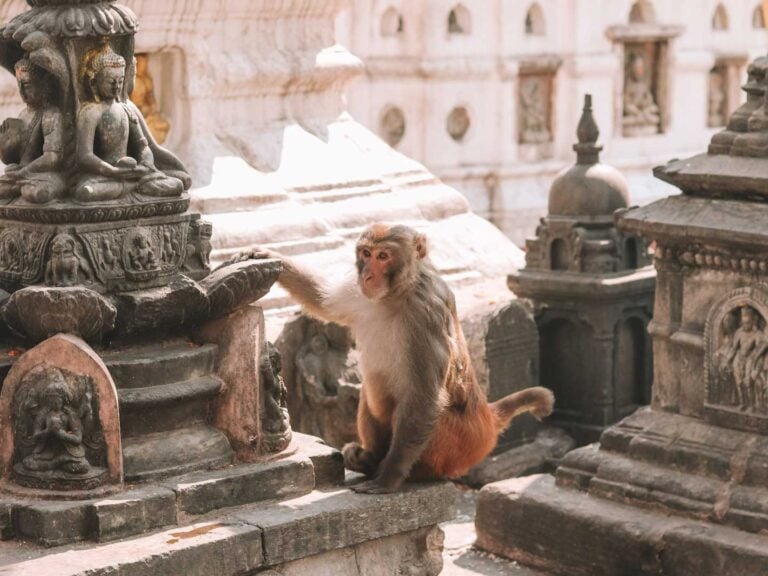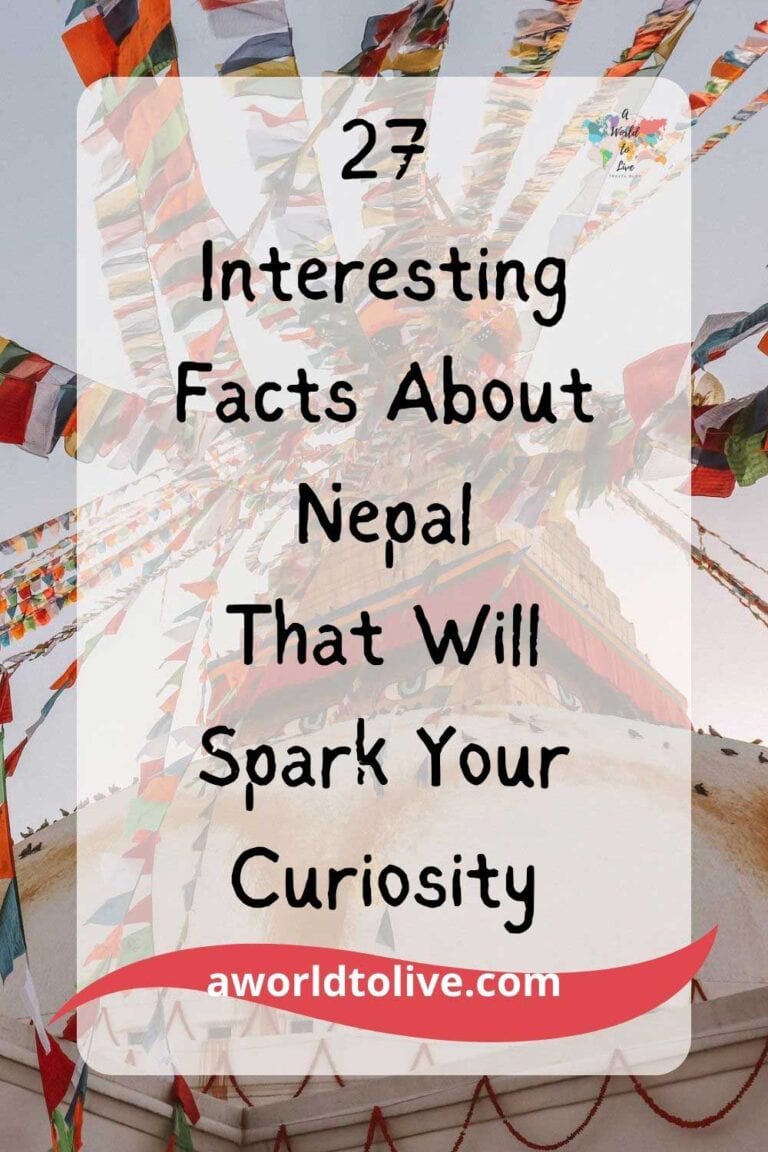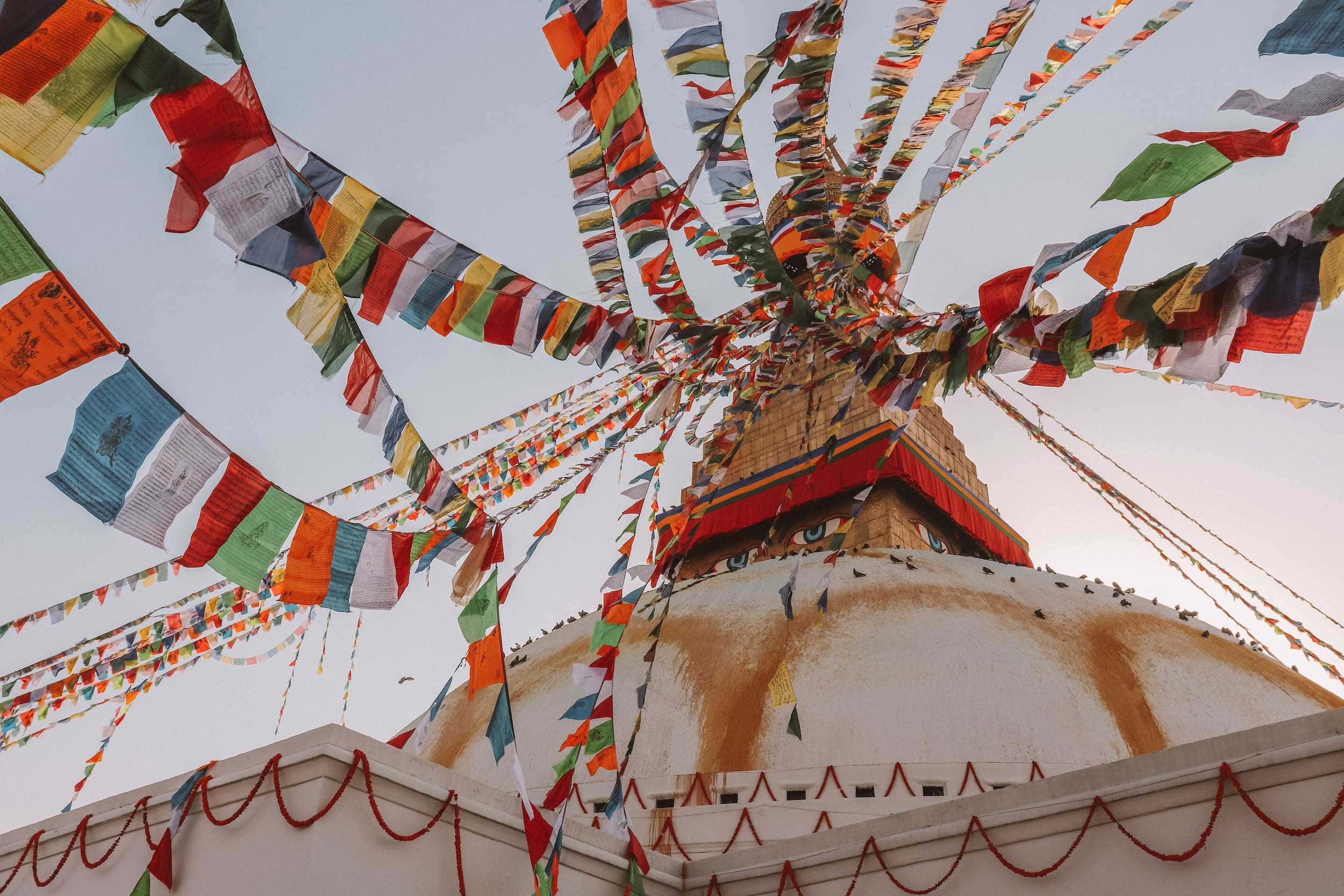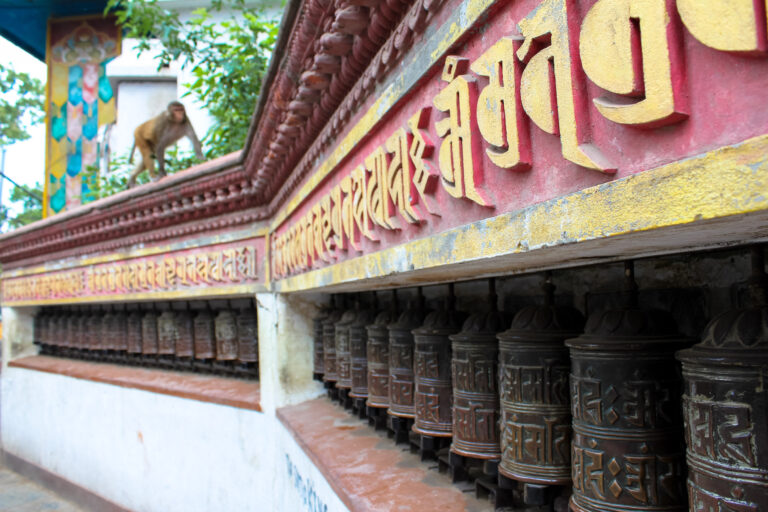Table of Contents
Home » Travel Guides » Nepal » 27 Interesting Facts About Nepal That Will Spark Your Curiosity
If you’ve started planning a trip to Nepal, or are just generally interested in this incredible country. Get ready to immerse yourself in this captivating list of 27 interesting facts about Nepal. Each one is more fascinating than the next and I’m sure will leave you yearning for more.
If you want to learn more about me and the many experiences I’ve had in Nepal, click here.
From the towering Himalayas that touch the sky, to the rich tapestry of cultures, and all that’s in between, Nepal’s allure is irresistible. This list of 27 interesting facts about Nepal uncovers the intriguing layers of this remarkable nation.

27 Interesting Facts About Nepal
Nepal Only Opened its Doors to Tourists in The 1950s
From 1816-1950, Nepal was completely shut off from the outside world. Then in 1949, they made the decision to open Nepal’s borders for mountaineering expeditions (and only to those accompanied by scientists). Then it took close to 5 years for Nepal’s commercial tourism era to really begin.
In 2021, Nepal saw 151,000 tourists visit and prior to covid, over 1 million people visited.
Perhaps this is why Nepal still feels somewhat untouched by the outside world. Their rich culture is still alive & well, and thankfully now accessible to the intrepid souls seeking Nepal’s unique blend of natural beauty, spiritual heritage, and warm hospitality.
Nepali Calendar
Did you know Nepal has its own calendar, and travelling to Nepal will have you stepping into the future?
At the heart of Nepal’s rich culture lies the Nepali calendar. It’s an interesting feature that offers a unique glimpse into the country’s cultural heritage. Known as the Bikram Sambat or Vikram Samvat, the Nepali calendar is currently in the year 2080. The origins of the calendar date back to the 12th century and carry both historical and religious significance.
The Nepali calendar consists of 12 months, each with its own festivals, rituals, and celebrations that intricately intertwine with the country’s way of life.
And, it’s worth noting when planning a trip to Nepal the Nepali New Year (or Navavarsha) usually falls in mid-April. This day always offers some fun celebrations.
There’s a Living Goddess in Kathmandu
The Kumari Devi is deeply respected in Kathmandu and resides in an elaborate palace near Durbar Square.
The locals worshipped the living goddess as an incarnation of Durga, a Hindu goddess. Once chosen based on strict criteria, she enters the palace at age 4 and retires at puberty to return to a normal life.
During her time as The Kumari Devi her feet will never touch the ground. The moment she enters the palace is the last time her feet will touch the ground until the goddess leaves her body. If she does venture outside the place she will be carried on her golden palanquin. Kumari makes short public appearances, seated at one of the palace windowsills. No photos can be taken of the goddess and security is very strict with this!
Population of Nepal
As of 2023, Nepal is home to approximately 30.9 million people. Some of the most densely populated cities in Nepal are Kathmandu, Pokhara and Patan. Although, even with the diverse and challenging landscapes, there are Nepalese residing all over the country.
There Aren’t Any Beaches
Landlocked between India and China, the absence of beaches is a geographical reality for the country. Coming from Australia I can’t imagine the idea of never having laid eyes on the ocean.
But despite the lack of coastal views, Nepal’s beauty lies in the mountains, cultural heritage, and diverse natural attractions, offering a unique and distinct experience for travellers seeking adventure.
Ethnic Groups and Spoken Languages in Nepal
The Kathmandu Post reported in June that there are now 142 castes and ethnic groups within Nepal. And, 124 languages have now been listed as being spoken in Nepal. The most commonly spoken languages are Nepali, Maithili & and Bhojpuri.
This is one of the most interesting facts about Nepal. And, the vibrant mix of identities and languages is a testament to Nepal’s multicultural heritage and geographical intricacies. Each ethnic group contributes unique traditions, cuisines and art forms. And, have created a harmonious coexistence that reflects the nation’s unity in diversity.
Nepali Citizenship
Unlike Australia and many other Western countries, where being born in your country to local parents is enough to grant you citizenship, things are a little different in Nepal.
When a child reaches 16 years old they can apply for Nepalese citizenship. To acquire citizenship by birth they need to permanently reside in Nepal and have a father who is a citizen of Nepal. Plus, to file this paperwork they need to return to the village where they were born (and from Kathmandu to remote villages around Nepal, this can be an extremely challenging journey).
For many obtaining Nepalese citizenship may come easy, but for abandoned or orphaned children, this can be very difficult. In cases like this, the search for distant relatives from the father’s side will commence.
Women are Warriors
Women aren’t always given equal rights in Nepalese society, a big one is the limitations in their ability to confirm citizenship for their own children. But even from birth society has a strong desire for sons and would prefer to educate boys over girls.
But women in Nepal are true warriors, they work hard day in and day out to provide for their families. Many of the jobs you’ll see women doing involve intense manual labour whether it be on the construction site or outdoors working the fields. Often with their baby tied to their back, as child care is not easily accessible.
I truly admire the women of Nepal, the strength, resilience and courage shown is unmatched.
Kathmandu is One of The Oldest Continuously Inhabited Cities
Not claiming to be the oldest city in the world but Kathmandu is still one of the oldest, continuously inhabited cities on the planet.
Founded in the 2nd century AD, Kathmandu and the valley was historically called Nepal Mandala.
Swayambhunath is The Oldest Stupa in Nepal
Now, I don’t know if the stupa at Swayambhunath (Monkey Temple) is officially the oldest in Nepal, but it’s certainly one of the oldest known Stupas in Nepal. Dating back to the 5th century.
Swayambhunath is a fascinating site in Kathmandu and is extremely important to the Buddhist community. No visit to Kathmandu would be complete without spending time at Swayambhunath.
If you’re finding this free guide helpful, please consider supporting my work!


Load Shedding and Power Cuts
Although not as bad these days, but the demand for electricity in Nepal often outweighs the available supply. So the government uses load shedding to relieve the stress on primary energy sources.
During many of my trips to Nepal, there have been up to 20 hours a day of scheduled power cuts. Families are given notice of the outages ahead of time but this can still cause significant disruption to daily life.
Thankfully since 2017, there has been no residential load shedding but, particularly in Kathmandu, homes still regularly experience power outages. These don’t usually last very long though.
There is no McDonald’s
If you’re one of those travellers who love trying McDonald’s in every country to discover the menu differences. Sorry, but Nepal won’t be one of them. Nepal stands out as one of the few countries where McDonald’s has not established a presence.
This absence is due to a combination of factors, including challenges related to supply chain logistics, and a focus on preserving local businesses. I personally love that there is no McDonald’s and as a result, Nepal offers more of an opportunity for travellers to savour its rich local dishes.
Birthplace of Buddha
Before travelling to Nepal it’s interesting to know that Nepal holds the distinction of being the birthplace of Siddhartha Gautama, who later became known as Buddha.
Lumbini, a UNESCO World Heritage site located in southern Nepal, is the revered birthplace of the enlightened teacher. Visitors to Lumbini can explore the sacred garden, Maya Devi Temple, and archaeological ruins that commemorate this historic event.
This significant pilgrimage site allows travellers to connect with the roots of Buddhism and the profound journey of enlightenment that began here.
Namaste
Namaste is a greeting you’ll hear multiple times a day in Nepal. The word means the divine within me, greets with the divine within you and is an expression of respect and appreciation towards others.
When using Namaste to greet others one should place their hands together, fingers facing upwards and slightly bow their head.
Peoples Heads Are Sacred
An interesting and important fact about Nepal is that people’s heads are considered sacred and of spiritual significance. Deeply rooted in the cultural and religious traditions, this belief emphasizes the head as the highest and most revered part of the body.
So touching someone’s head, especially without permission, is considered disrespectful. Similarly, pointing the soles of your feet towards someone’s head or a sacred object is considered impolite, as feet are the lowest part of the body.
Even with the many ethnic groups that coexist in Nepal understanding and respecting this cultural perspective is a vital aspect of engaging with the local customs and traditions while visiting Nepal.
Eating in Nepal
There are many Nepali taboos related to food. So it’s important to take note of these few facts to ensure you’re being respectful.
If eating with your hands only ever use your right hand. Your left hand is for washing up after using the bathroom. When sharing drinks with others ensure your lips don’t touch the cup or bottle and never eat off someone else’s plate or offer food you’ve already taken a bite from.
Also, it’s considered very good manners to give and receive everything with your right hand, with your left touching your forearm. This not only includes food but also payments and gifts.
Festivals in Nepal
Nepal is a land of vibrant festivals and throughout the year the country showcases its rich cultural and religious diversity. From the lively colours of Holi to the spiritual warmth of Dashain and Tihar.
Throughout the year there are always festivals being celebrated. So, no matter when you visit Nepal there’s a good chance you’ll be able to experience one of the many Nepali festivals. Tourists are welcome to join in on the celebrations and become immersed in the kaleidoscope of traditions. Indra Jatra, with its stunning chariot processions and mask dances, and the mystical celebration of Buddha Jayanti, marking the birth of Lord Buddha, are just a glimpse of the numerous festivals that offer travelers a unique opportunity to witness the joy, devotion, and cultural heritage that define Nepal’s festive spirit.
Nepal even has a festival called Kukur Tihar, which is all about worshipping dogs. Aww! Throughout the country, you will see pet and street dogs decorated with a Tika and have a flower garland draped around their necks. Kukur Tihar is a Hindu festival and falls on the second day of Tihar. Their reason is to please the Hindu god, Yama, the god of death. Hindus believe that dogs are his messengers.
Always Walk Clockwise
When visiting any sacred Buddhist site, whether it be a monastery, temple or stupa, it’s important to remember to walk in a clockwise direction, keeping the site to the right of you. This also includes spinning prey wheels.
Walking anti-clockwise is a sign of disrespect and is considered a sin!
The very first time I visited Boudhanath back in 2009 I had no idea about this. My friend and I were stopped by a very kind local who pointed us in the right direction and explained the reasoning behind it.
Facts About Health in Nepal
Nepal often presents health concerns for travelers and although I don’t believe this is cause for concern, I still think travelers need to take this into consideration.
Altitude sickness is a possibility in high-altitude regions like the Himalayas, making acclimatization during treks essential. There are also a number of effective precautionary medications available.
It’s advisable to only drink bottled water and consume well-cooked food to prevent waterborne illnesses.
The air pollution in Nepal’s major cities isn’t great. And, is actually considered ‘unhealthy for sensitive groups’. There are many factors for this including rapid population growth, particularly with Kathmandu and how it’s located deep within a valley. Plus, the use of outdated vehicles.
Healthcare facilities in Nepal vary in quality and accessibility, particularly in remote areas. I would recommend all travellers have comprehensive travel insurance and necessary vaccinations before their journey to Nepal, ensuring it is as safe and healthy as possible.
Holy Cow
Cows play a major role in many religions around the world, particularly in Hinduism. In Nepal, cows are worshipped and considered sacred as they represent all of the gods and goddesses of Hinduism.
You will never find beef on the menu, as cows are protected under the law and it’s illegal to kill them for food or otherwise. If this law is broken up to 12 years in prison can be the consequence. Dairy farmers in Nepal are even known to set their cattle free once they stop producing milk.

The Squat Toilet
Ahh the joys!
I can’t say I’m a fan of the squat toilet but a fun fact about Nepal, if you plan to visit places outside Kathmandu, there is a very good chance you will be using one at some point.
Thankfully most places in Kathmandu will have western toilets but when visiting remote villages or at many of the country’s bus stations and airports. The squat is your only option.
Please don’t think I’m being disrespectful here, I know for many people around the world squat toilets are all they know. I’m just used to the other type and can find squat toilets a little challenging.
And, another thing to remember is toilet paper in Nepal isn’t always used or provided, so always keep some in your bag.
Nepalis Don’t Complain
Nepali people don’t complain or spend their time worrying, no matter how bad things get.
Over the years Nepalis have certainly had things to complain about, whether it be the surging fuel prices, even when the price in other countries is falling. High-level corruption, lack of government assistance after the earthquake or poorly made infrastructure.
But it’s just not in their nature, they know things could always get worse and love to live in the moment.
This is one of my favourite aspects of Nepal. The happiness and sense of calmness are infectious and I always leave feeling better than what I did when I arrived.
Highest Peaks in Nepal
People know that Nepal is home to Mount Everest, the highest peak in the world. But further to that an interesting fact about Nepal is that out of the 10 highest peaks in the world Nepal is home to a whopping 8 of them.
This is one of the most awe-inspiring aspects of Nepal. The majestic Himalayas define the landscape, with iconic summits like Mount Everest, Kanchenjunga, and Makalu standing as testaments to the country’s remarkable natural beauty.
Plus trekkers from around the world bring millions of dollars to Nepal’s economy each year.
These towering giants not only attract avid trekkers and mountaineers but also offer breathtaking viewpoints from places like Pokhara and Nagarkot.
Mount Everest Real Name
Everyone has heard of Mount Everest but did you know Chomolungma is the centuries-old Tibetan name for Everest? And, this was found published on a map in 1733.
The name Chomolungma means ‘Goddess Mother of the World’.
Endangered Animals of Nepal
The country’s diverse terrain shelters a wealth of wildlife, but Nepal’s endangered species list is larger than some may think.
The Bengal tiger and one-horned rhinoceros find sanctuary in Nepal’s national parks, including Chitwan and Bardia. Then, the endangered red panda and elusive snow leopard call the rugged landscapes of the Himalayas home.
Exploring Nepal not only offers the chance to witness these incredible animals in the wild but also highlights the importance of responsible eco-tourism and the efforts needed to protect these magnificent creatures.
Nepalese Gurkhas
Before travelling to Nepal you may not have heard of the Nepalese Gurkhas. So, who are the Gurkhas?
Gurkhas are elite soldiers from Nepal who have served in the British army for almost 200 years. Famed for their exceptional courage & loyalty and are a vital part of the British army.
Nepalese Gurkhas originated from the rugged hills of Nepal, in an area named Gurkha. Today the British army recruits up to 400 individuals each year. To apply you must be Nepalese and live in Nepal, plus pass the physical entry standards.
A bonus for those Gurkhas who wish to become UK citizens, they’ll have the opportunity to apply for settlement, naturalization, or citizenship to the UK.
Nepal Earthquake 2015
Lastly, on this list of interesting facts about Nepal, is the devastating earthquake that struck Nepal on April 25, 2015. It still pains me to think about this day! Although I wasn’t in Nepal at the time it was still a difficult day not being about to reach my dear friends for so many hours and then to hear of the daily struggles in the aftermath.
The earthquake that suddenly hit Nepal in 2015 had a magnitude of 7.8, killed approximately 9 thousand people and injured many more.
This catastrophic event resulted in widespread destruction, not only claiming lives but also causing immense damage to historical monuments, infrastructure, and communities across the country.
The earthquake’s impact was particularly profound in Kathmandu, where centuries-old temples and UNESCO World Heritage sites were severely affected.
The disaster prompted an international response for relief and rebuilding efforts, and it was incredible to see how the world reached out to help Nepal.
The earthquakes highlighted both Nepal’s resilience in the face of adversity and the global community’s willingness to come together in times of crisis.

27 Interesting Facts About Nepal ~ In Conclusion
As someone who has explored Nepal’s breathtaking landscapes and vibrant culture since 2009, my hope is that these 27 interesting facts about Nepal have ignited a spark of curiosity to visit Nepal sometime soon.
Nepal isn’t just a destination; it’s a feeling. From the world’s highest peaks to the serenity of its ancient temples, the warmth of its people, and its vibrant culture, Nepal awaits for you to step into a world unlike any other.
If you would like to explore more of my Nepal travel guides, click here.
Have any of these interesting facts about Nepal surprised you? Comment below which ones you found most interesting.
Thanks for reading,
Happy Travels.
If you found this information helpful, please consider booking your trip via my affiliate links. This won’t be at any extra cost to you and will help fund this blog, thank you.
Like this Article?
Pin These Interesting Facts About Nepal!


If you like this list of 27 interesting facts about Nepal, I would love for you to share it with your friends.
Planning a Trip? Travel Resources Below;
Searching For The Best Flights
Without a doubt the best site for comparing and booking flights is Skyscanner. Just click here to compare flights and get the best prices with Skyscanner.
Booking Accommodation
Click here to save on accommodation, from hostels to luxury hotels!
Get Cashback on Bookings
Before you book don’t forget to activate your Rakuten browser extension so you get cashback on your travel bookings.
Don’t know what Rakuten is? Read my guide here!
Never Skip Travel Insurance
Unfortunately, everything doesn’t always go to plan but travel insurance will protect you when it comes to illness, injury, theft & cancellation. I never travel overseas without travel insurance, it’s just not worth the risk!
Cover-More is a trusted company, who have a good reputation for making customer claims a hassle-free process.
Where to Next?
If you’re unsure of where to visit next, why not check out my Destination Page filled with exciting ideas from all over the world?

Elyse is the author & content creator behind A World To Live. After traveling to over 40 countries, she has a passion for discovering new places. Elyse is a money-conscious traveller who loves writing independent travel guides to help her readers get the most out of their travels.




![Read more about the article Trek Annapurna Base Camp, Nepal. Insiders Guide to This Incredible Journey [Updated]](https://aworldtolive.com/wp-content/uploads/2019/08/ABC-trek-view-with-prey-flags-fi2-768x512.jpg)
This was such an interesting read about Nepal! Loved learning all the different facts about the country especially about walking clockwise. All these are helpful for first-time travellers to Nepal.
I think Kukur Tihar should be celebrated everywhere! 😊 🐶 ❤️
I agree Jennifer 🥰
You have documented some really interesting facts about Nepal. The calendar is similar to some of the states in India. Absence of beaches is a unique geographical feature indeed. Great post.
So interesting! I had no idea the country wasn’t open to tourists until the 50’s – that’s fascinating.
Such a good guide. Good to know about the eating rules and the clockwise walking.
Thank you for sharing!! The festivals sound like they’d be so much fun. I can’t wait to go – Nepal is on my list!
What an interesting post on Nepal. I can see some commonalities like holy cow, eating habits, even squat toilets between India and Nepal. Hopefully will travel soon to this neighbouring country.
What an interesting post! I would LOVE to visit Nepal, try that amazing food and see some of those epic mountain views!
It’s pretty cool to hear the real name of Chomolungma/ Mount Everest. I wonder if they will ever change it back on maps. It seems like there is more of a push to do that with original indigenous names around the world…
That’s a very good point Josy, that’s happening a lot more in Australia too. Even though it’s harder to pronounce 😆 I would love them to change it
Despite having visited Nepal, I didn’t know many of these interesting facts. I’d never heard of the Kumari Devi or realised how challenging obtaining Nepalese citizenship could be. Thank you for sharing!